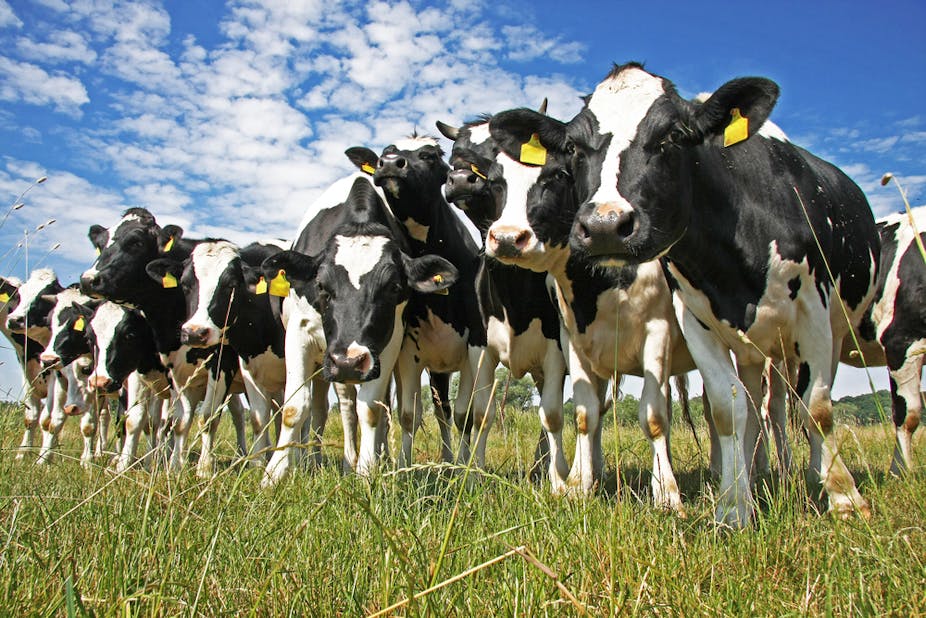Despite scientists’ intensive efforts over many decades, bovine tuberculosis continues to be a problem in many parts of the world, not least in England, where it leads to the slaughter of thousands of cattle every year – 38,000 in 2012. The tiny Mycobacterium bovis bacterium that causes bovine TB has a huge impact on the health of livestock, and farm profitability.
It’s become clear over the past few years that some of the variation in bovine TB is underpinned by the genetic makeup of the cattle. A number of quantitative genetic studies have estimated that the heritability (the proportion of the variation accounted for by genetics) is significant in the major dairy breed, the Holstein-Friesian. These studies indicate that it would be possible to breed cattle that are naturally more resistant to bovine TB.
Our research paper recently published in Heredity offers new results which indicate that it should be possible to use genetic markers (known as Single Nucleotide Polymorphisms, or SNPs) to breed cattle that are more TB-resistant. Holstein-Friesian cattle were carefully chosen from herds with high prevalence to ensure that cases and controls were exposed to infection to the same level.
Computerised genetic scanners, known as SNP chips, were used to identify differences in the genomes of more than 1,000 cattle that, given equal exposure to infection, had either contracted bovine TB or had not. By identifying more than 600,000 points across the cows’ genomes and combining all the differences detected, it was found around 21% of this breed’s liability to become infected could be accounted for by genetics. This means it’s possible to tentatively identify the elements of the genome associated with TB resistance.
It is important to emphasise that our study compared TB infected cows, as determined by the standard test used by farmers and with laboratory confirmation, with cows that were highly likely to have been exposed to disease, but reacted negatively to repeated skin tests. We carefully chose these animals from herds that had high incidences of bovine TB, and tracked the eventual outcome of the animal to confirm our definitions of them as infected or uninfected were correct.
In other words the genetic trait we investigated relates to TB infection, and not just a differing response to the skin test. We consider that the resistance trait relates to an innate genetic ability to prevent or eliminate infection, not to adaptive immunity.
TB is a moving target
At first, TB attacks the white blood cells that help fight infection, and it’s likely that any genetic resistance to TB from the innate immune system, the body’s first line of defence, attacks the pathogen at this stage. This is the most likely explanation for those animals exposed but not infected (controls).
If the animal becomes infected, then the TB-specific adaptive immune response can try to fight the infection, but this is dependent on the innate response happening first. This response takes time to develop, and shows up in the skin test for TB.
But genetic differences are not the only factors – the environment and perhaps even differences between strains of TB also play a role. And while we studied the Holstein-Friesian breed, we don’t know how the genetics of other breeds of cattle, such as those common in beef herds, affect their susceptibility to infection. But there is evidence from Ethiopia that zebu cattle that are kept there are more TB-resistant than the Holstein-Friesian breed kept in the UK.
These studies were only possible due to the data on TB infection that is routinely collected in the UK and the Republic of Ireland.
We can breed better cows
Future breeding programmes based on an understanding of genetic resistance to TB should be introduced alongside other TB control strategies. A project from dairy farmers’ organisation DairyCo and SAC Commercial Ltd is the first step, and will carry out a national genetic evalulation of pedigree data for Holstein-Friesian cattle.
These sorts of genetic evaluations are carried out routinely to select beneficial traits such as high milk yield or long-lived cows. With the costs of bovine TB so high, it makes sense to do the same for TB-resistance.
By starting with the genetic markers our study identified using the SNP chips, this process could be carried out much faster – the SNP data will be more accurate, and the potential improvement in TB-resistance would be seen much more quickly in the next generation of cows.

